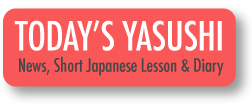Welcome to NY Japanese Language School!
Today's Yasushi
泰史的每日小课堂/야수시의 하루
Happy New Year 2019!
新春 あけまして おめでとう ございます!
Visit our Blog!
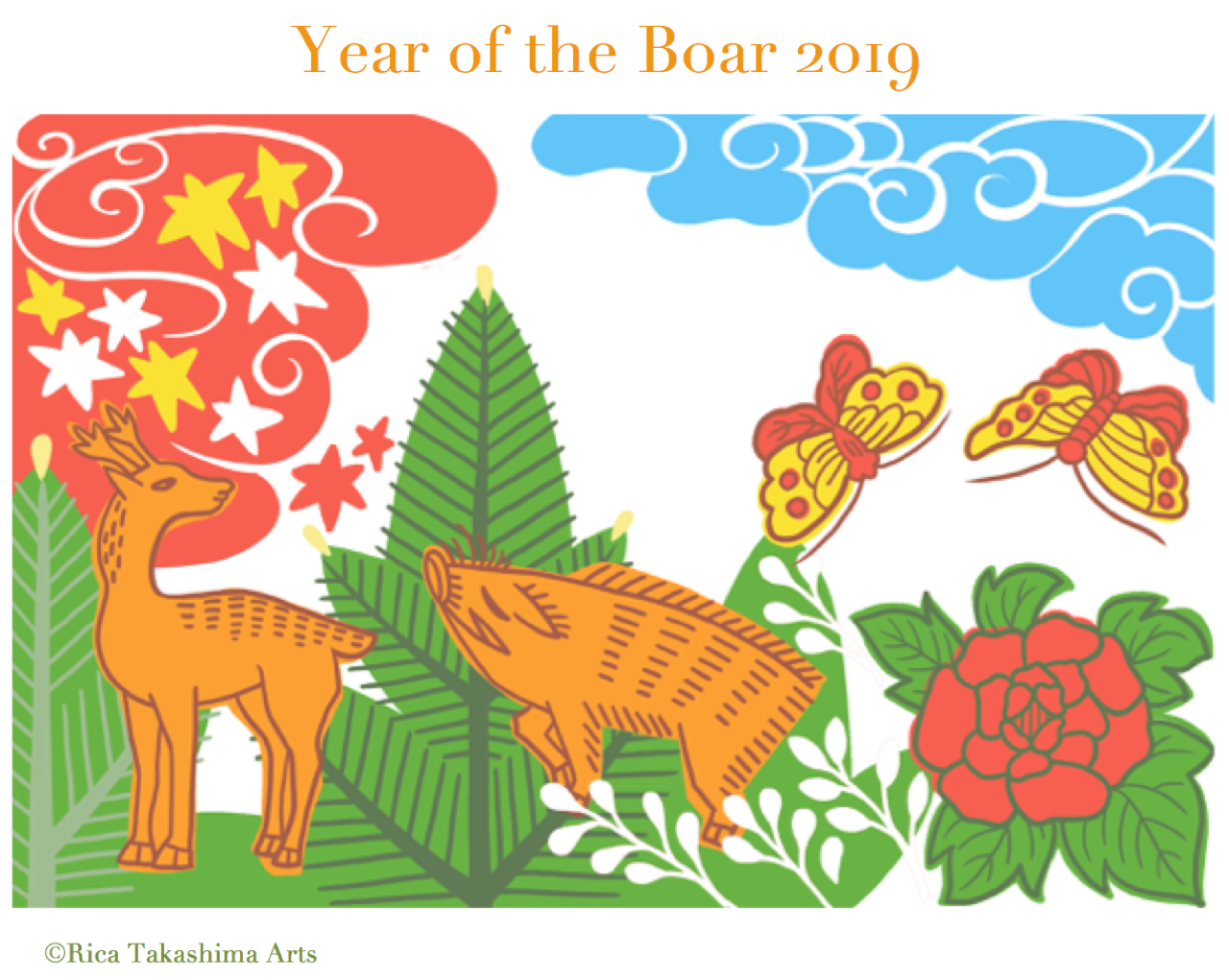
June 2014 |May 2014 | April 2014
-special serialization-
Collin’s Corner
Intro:
At the end of 2012 I began studying Japanese with Yasushi Sensei. On April 1st, 2015, I packed up everything I owned, got on a plane and moved to Sapporo, Japan. Just in case you don’t know, Sapporo is located in Hokkaido, the large island in the north of Japan. Hokkaido is not as heavily populated as the rest of Japan, but Sapporo is almost 2 million people, making it Japan’s 4th largest city. In Sapporo, I will study Japanese for 2 years at the Japanese Language Institute. While I’m in Japan, I look forward to having lots of fun adventures and meeting lots of new people! I hope you enjoy reading about it!
July
2016
Hey guys!
How’s your summer? It’s getting hot in Sapporo, but it’s not nearly as hot here as New York, so I’m managing. J Last weekend, I went to Join Alive, a festival in Iwamizawa, which is about an hour away from Sapporo by car. I had a blast, and thought I’d tell you about going to see live show’s in Japan. I don’t think there is a ton of info about the details of seeing shows here, and some of the differences between here and America might surprise you. Spoiler alert, going to see live music here is hands down a better experience than seeing shows in the states.
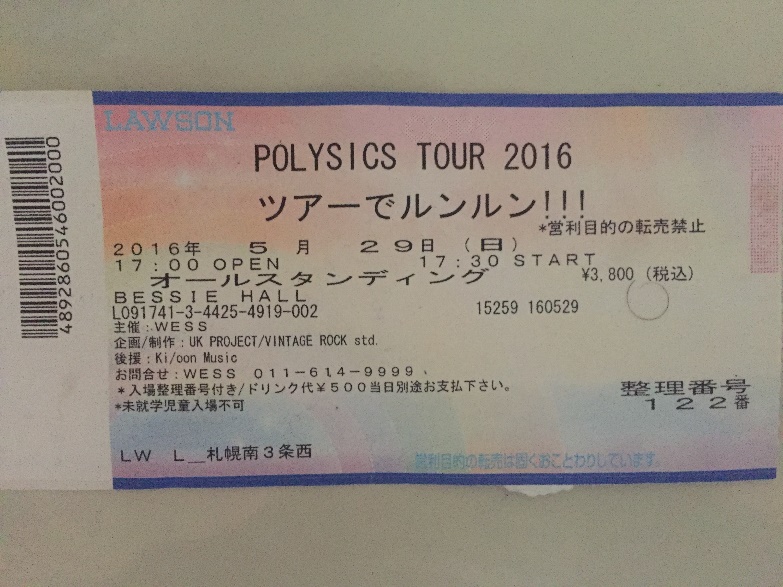
First, let’s talk about tickets. In America, you almost always get your tickets online, and while that is an option here, too, it’s way more common to buy them at a convenience store. At Lawson (a very common convenience store chain), you use a machine called Loppy. Using machines like this is so common that most information about shows online will have a code (the code for Loppy is called an L-CODE) that’s specifically for use with machines like these. If you have the code, all you have to do is enter it into the machine and the correct show will pop up on the screen. You can also just search via artist or venue or whatever, but Loppy isn’t very good at guessing so if you make even a slight spelling error, it won’t be able to locate your show, so it’s best to have the code. After you have found the show, you enter your name, etc., and then the machine prints out your receipt. You take the receipt to the register, the clerk, prints out your tickets and you pay. Now you’re ready to go see the show! Side note: concerts are more expensive here. It’s not uncommon to see a small show of Indy bands for under ten dollars. That same show would be 15 or more in Japan.
Next, let’s talk about going to see the show! Get to the venue on time!! New York shows often start almost an hour after they are supposed to, but in Japan, if the ticket says the show starts at 7:15, you can be certain it will start at 7:15 on the dot. For shows at any medium size or larger venue, your ticket will have a number printed on it (on the ticket, above, my number was 122). This number indicates where you are in line to get into the venue once doors open. Unless I have a pretty early number, I usually don’t do this. But if I have good tickets it’s pretty cool to be guaranteed a spot up front even though it’s a standing room only show.
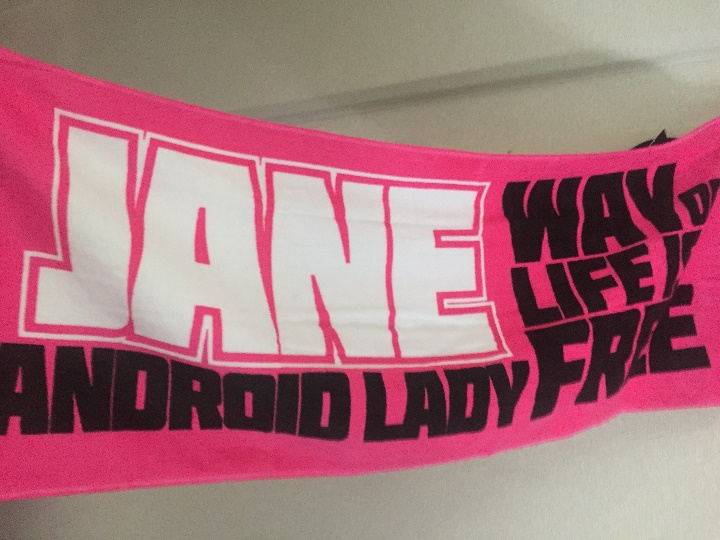
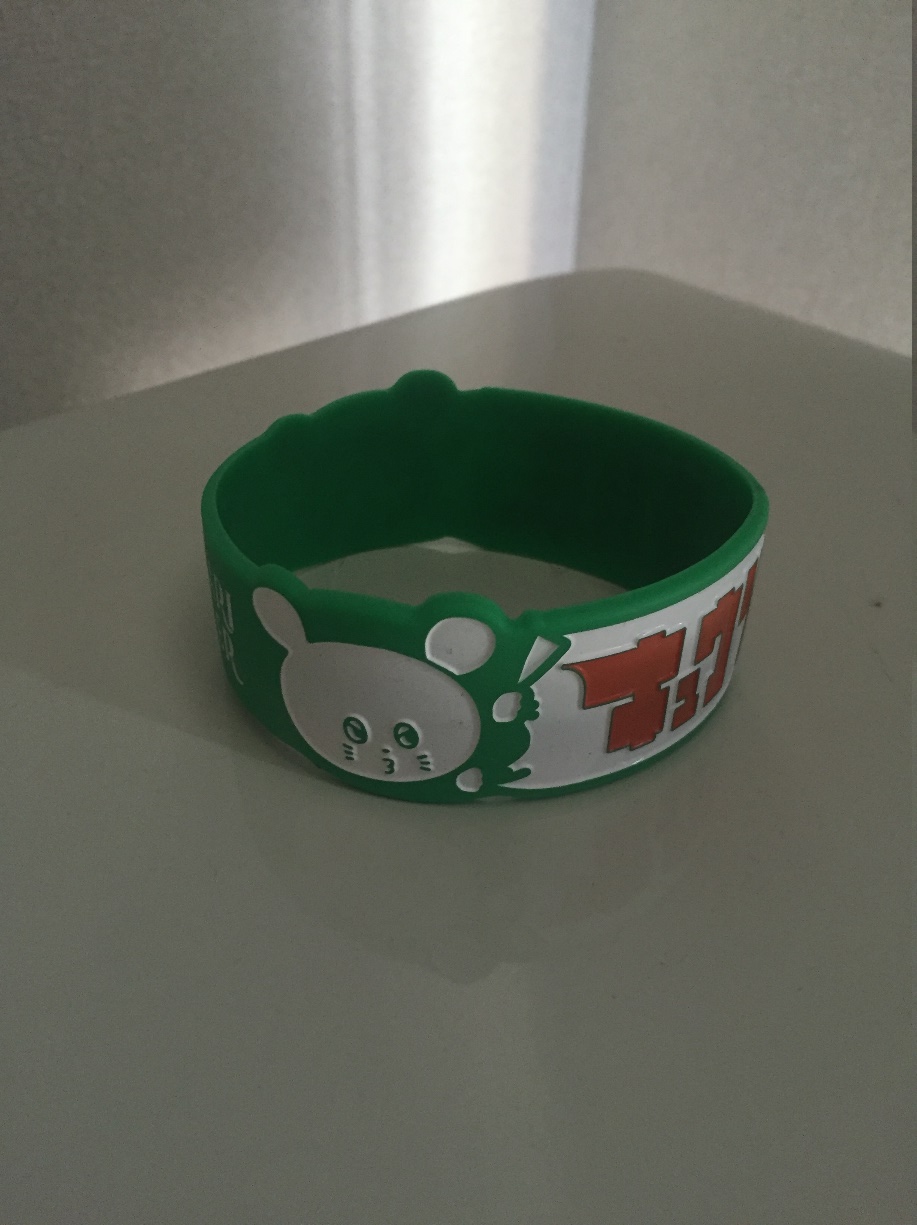
On your way into the show, you might want to check out the merch booth. Merch is a very very serious business here—even smaller bands will have their cds, some t-shirts, and few other accessories on sale. There are a few common purchases that I would like to point out. One of the things that almost everyone buys is a towel (example on the right). Smaller than a bath towel, but longer than a hand towel, these will have the band’s name and some kind of design printed on them. People usually wear these like a scarf, and during the show people will definitely be waving them over their heads to the beat of the music. The other common item you will see here are rubber bracelets (see below). These are the cheapest merch option, and since merch designs change every tour, a lot of people collect these. And that brings me to another important part about merch, which is definitely very different from the states. In Japan, you where the bands merch to the show. It’s not uncommon to see someone decked out in a t-shirt, towel, and several of the bands bracelets.
I know I mentioned that merch is a serious business here, but here’s how serious. The merch booth opens BEFORE the venue! Last time I went to see a bigger band play, the merch booth opened at 2 pm outside the venue, and stayed open until 4:30 pm. The merch was then moved inside the venue, doors for the show was at 5:30 pm. We went at 2:30 to buy merch, or “goods” as they are called here, but we waited almost 45 minutes to get to the front of the line, even though there were six people selling merch! If you want merch, get there early because the really cool stuff will sell out!!
So you have your merch, you have thrown your bag into a coin locker (which most venues have a plethora of), and you’ve changed into your new t-shirt. It’s finally time to see the show. Hope you brought an extra 500 yen (about 5 dollars), because you will be required to pay this for one drink ticket at the door. Even if you don’t want to drink. I don’t like to drink at shows since I don’t want to give up my spot, but this fee isn’t optional.
Okay, it’s show time! For bigger bands, it will usually be what is called a “one man,” which means that only the headlining band is playing. If this is the case, you can expect the band to play around 2 hours. Otherwise, there may be opening bands, just like in the states, but everything will start on time. Seeing a show in Japan is really awesome because people are there to see the music. You won’t be distracted by people talking, though you may be bumped into by someone dancing. Also, people will wave their hands back and forth in unison during almost every chorus. There seem to be several “moves” that people prefer, and they all seem to know which move to do and when, but I have yet to unlock the secret of this J
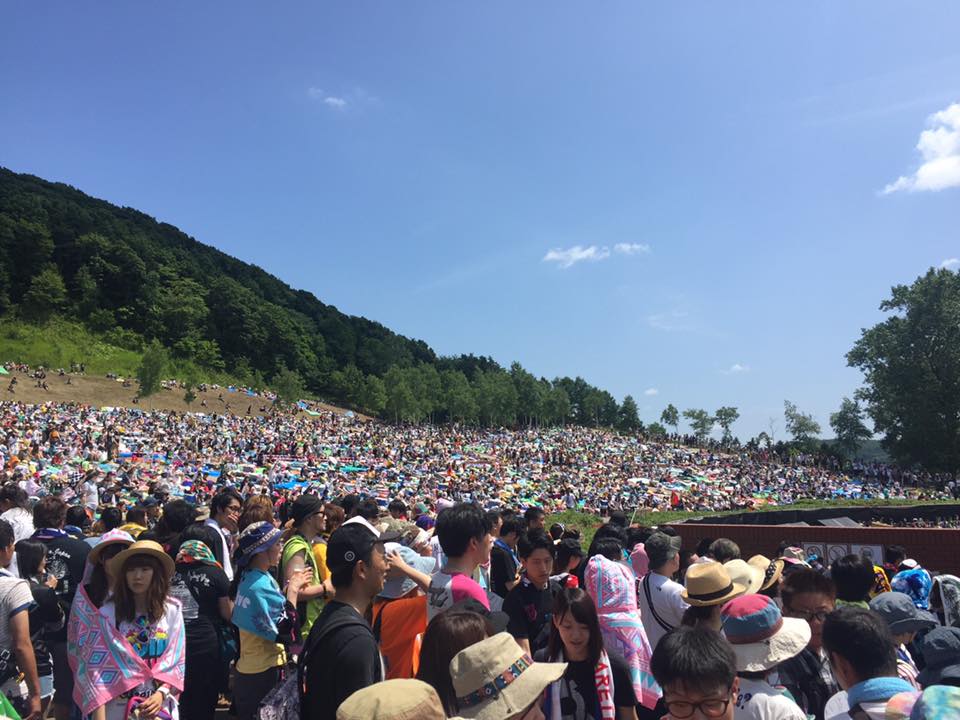
On the other hand, if the space is crowded and people do bump into, don’t expect an acknowledgement or apology. Japan seems to be known for its politeness, but there seem to be times that politeness is not required, and one of them is extremely crowded places. As someone who had the importance of saying “excuse me” drilled into them from childhood, this small change made me really mad at first, but that’s how things are. I’m not sure what threshold needs to be passed before it is officially okay to not bother apologizing, but crowded venues and subways seem to be accepted places for this lack of protocol. This, however, is my only real complaint about live shows here, and I’d rather be bumped into than have to listen to strangers’ conversations.
Besides people being generally quiet, you may also notice that the sound quality is impeccable. Even at small venues with a bunch of no-name bands, or at a huge outdoor festival, everything will sound good! There’s not much else I can really say about it, I guess. This point is probably the most important, but requires no more explanation so it’s the shortest one! Lol
One final note about shows in Japan, and it’s an important one. No pictures allowed (Were you wondering why there were no pictures of shows in a post about live music?!). And everyone follows this rule. Even at a festival where you would think it wouldn’t be noticed, I watched the singer of a band get very angry and someone taking a picture and threaten to call security. So for reals, don’t take pictures unless the band says it’s okay. This will happen too, but it’s very rare.
So, that’s the rundown of seeing a show in Japan basics. There are so many differences between the states and Japan. And some of the coolest things about Japan have nothing to do with temples or other things you are sure to see in a textbook. It’s an adventure, and you should come here and see for yourself.
January
2016
Hi everyone! It’s been awhile! How are you?
I thought for sure I would be more punctual about writing, but I’ve been super busy with work and school. I even did a little traveling! After that, I had a 3 week winter break, so I went back to New York for the holidays. Since I haven’t written in a while, I’ll do my best to give you the highlights.
Here is the same viewpoint near my school in October and December. Sapporo is pretty all year round!
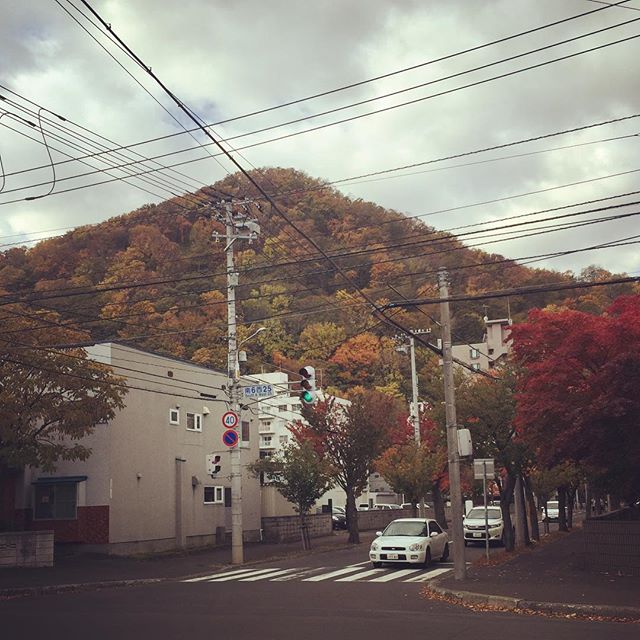
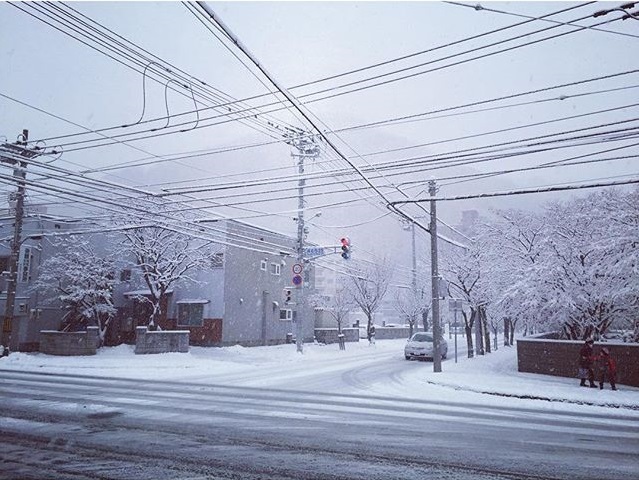
First, my travels! I went to Tokyo on Halloween weekend! I wasn’t a very good blogger though, and I didn’t take too many pictures. Sorry! I had never been to Tokyo before and I couldn’t wait to see what it was like. Having lived in New York for such a long time, I wasn’t really interested in going to places like Shibuya or Akihabara, but a friend and I had tickets to go see a band I really like, and the venue was in Shibuya, so I ended up in Shibuya on Halloween! It was insanely crowded. Almost to the point that we couldn’t move. Fortunately, people were better behaved than they usually are in Times Square, so we got to our destination eventually.
Like I said before, I wasn’t so interested in tourist spots, but really wanted to get a feel for the parts of the city that people actually lived in, so we spent a couple hours walking from where we (my friend and I) were staying in Koenji, south to Meguro. We stopped along the way to grab a beer or have a snack. It was only a couple hour walk, but we took it slow with the eating and the drinking, and then we hopped on the subway to head to Shibuya for the show.
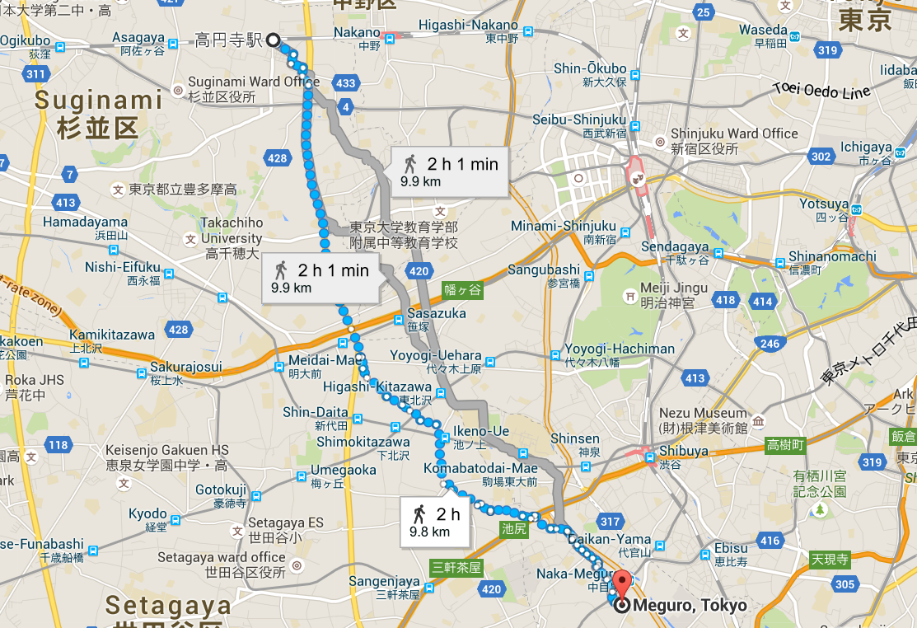
I was much more of a tourist on my second trip outside of Hokkaido. I went to Kyoto, but only for a weekend. Unfortunately, it rained the entire time, but I still managed to see a temple (Kinkakuji) and take a walk in Arashiyama, which was probably the most beautiful spot I had seen in Japan until then.
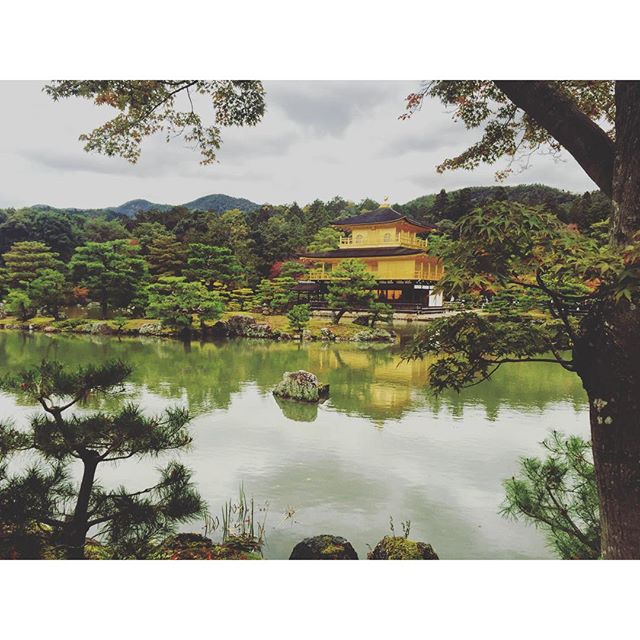
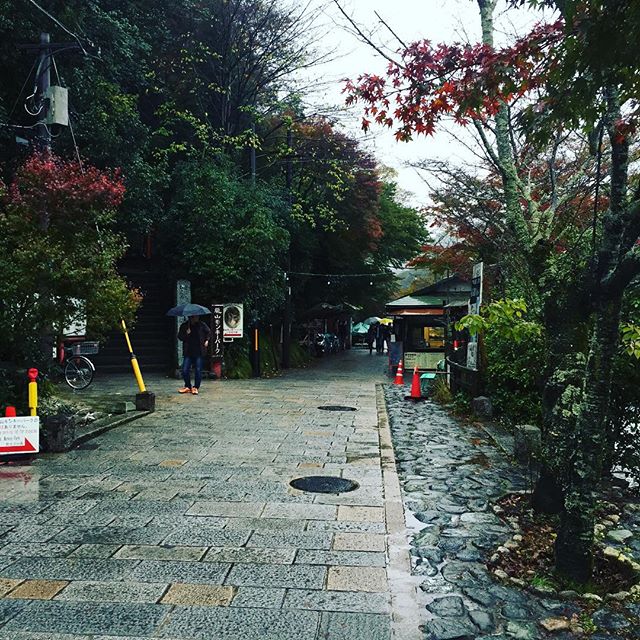
The path along the river at Arashiyama was filled with scenic spots, which the fog from the rain made all the more beautiful. Eventually we wound up at a small shrine in the mountain where we were able to dry off a little bit before heading back down. For a brief moment, I felt like I was in Princess Mononoke or something! You really have to see it for yourself!
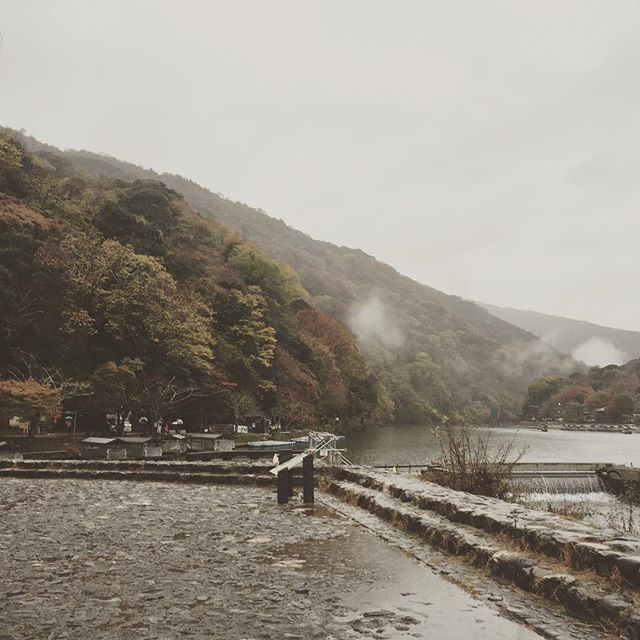
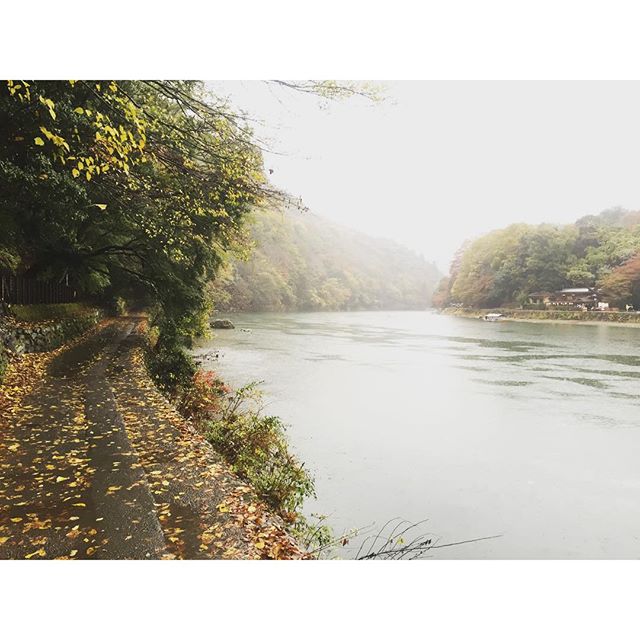
I went to Kyoto because a close friend was visiting Japan for a few days but couldn’t make it up to Sapporo. I really wanted him to have some of the amazing food that I had grown so accustomed to living up north, but without any knowledge of the city, I wasn’t able to find anything really spectacular. Plus, I thought it would be fun for him to experience an all-you-can-drink/dinner at an Izakaya, so we went to a chain that I knew offered this, only to find out that doing so required a reservation (which is not the case in Sapporo). And that’s when it struck me: Sapporo is pretty rad. The food is cheap but amazing, and if you want an all-you-can-drink menu, it’s only going to cost you about 1,000 yen ($10 US). Since I had spent my time in Japan only in Sapporo, I hadn’t realized that some of the things I enjoyed about Japan were really things I enjoyed about Sapporo. Things like this may seem trivial, but it was at that time that I began to really appreciate Sapporo, and from then on, everything about Sapporo started to feel more like “home”.
But when I really started to feel like Sapporo was “home” was when I returned from Winter break. After a full day of travel, I got off the bus that stops near my place almost 24 hours after I had started my trip. It was around 10pm, and the street was quiet and snow was falling. When I got back to the share house, my friends had dinner waiting form me! It felt good to back, relaxing with good friends, good food and a cold beer.
The next day, another group of friends picked me up and we drove an hour south to a hot spring. It was gorgeous (unfortunately, it’s not really okay to take a camera so I don’t have pictures, but I found one on the hot spring’s website). The spring was right on the shore of a giant lake so we sat in the in steaming water taking in the view of the lake. Starting in February, they have a snow sculpture festival there, too, so I’m really looking forward to going back!
So that wraps up my “in a nutshell” version of the last few months. So far, I’ve been focusing on places I go and things that I do, but from here on, I’m going to be spending a little more time discussing things like cultural differences (good and bad) in more detail. In this way, I hope you can get a more detailed look at what living in Japan is really like! Please look forward to it!
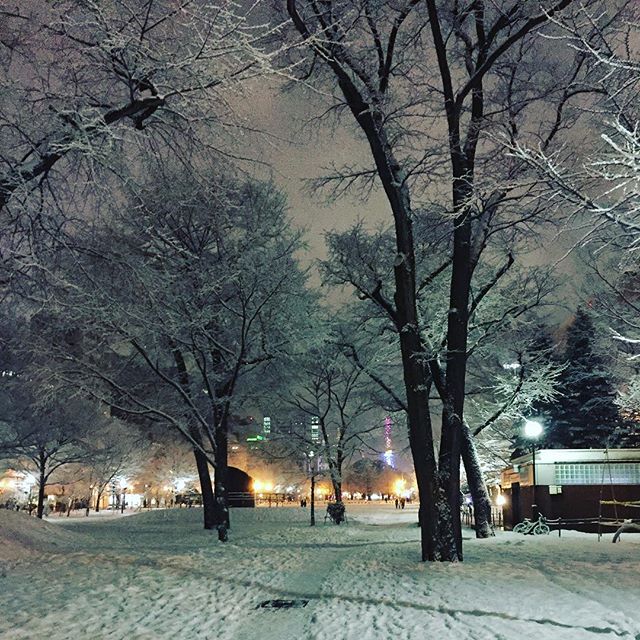
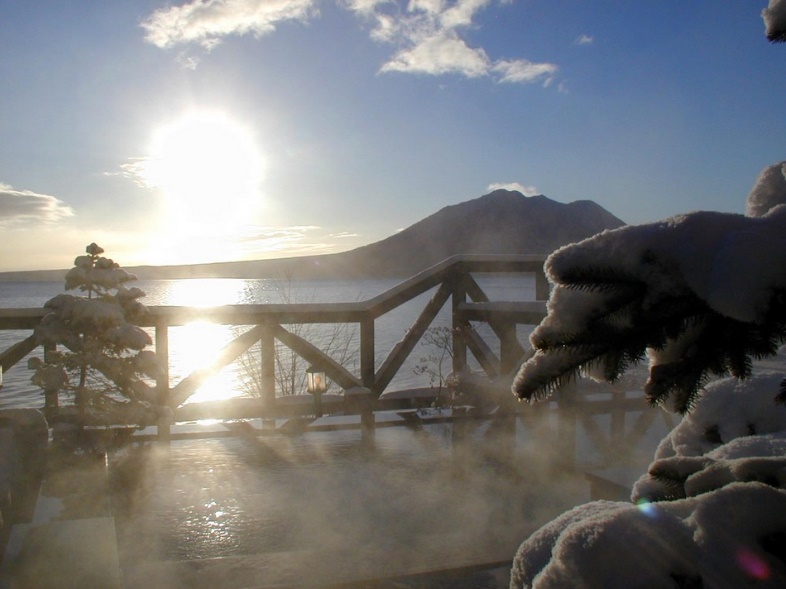
September, 2015
How’s it going, everyone? It’s really cooled off here in Sapporo! We are even supposed to get our first now at the end of October!! I really can’t wait for snow!
September found me back in school after a month of summer vacation, and feeling more and more acclimated to life in Japan. Unfortunately, one of my first friends here left for a year abroad in Canada at the end of the month, but before he went, we took a trip to an Onsen (Japanese hot springs) before he left. But more on that in a minute.
This month I also found a new job, working as a translator and checker at a translation company! It’s a great job for learning new kanji and vocab, and because my future goal is to translate fiction, it’s definitely good practice. Before starting the job, I had translated a short story by myself, but I had no idea how many different kinds of translations there are. When translating a short story, the main goal is to capture the artist’s voice, so it’s more important to use words that evoke a similar feeling than it is to keep the exact same structure as the original text. Not so at my new job! We do a lot of translations of business info, subways signs and other info of that sort, as well as instruction manuals. Manuals are by far the most tedious; you have to include a translation for every word of the original text and there is no room for creativity. With signage, the amount of characters and the space the words take up on the page is almost as important as the content of the translation, so sometimes you really have to think in order to make the words fit. If that sounds tedious, it’s because it is, but I also think it’s a really fun puzzle. I’ve really been enjoying going to work these days.
However, my money problems are far from over… it seems like the only way to make a wage that is high enough to support yourself in the 20 hours a week a student is legally allowed to work is by being an English teacher. It’s something I’ve been avoiding because I came here to learn Japanese, but it may be that I have to do that kind of job eventually. We’ll see. Even my translation job, which pays a really good wage by Japanese standards, is less than half what my English teacher friends are making. But I really don’t want to teach English…
But enough about my problems, let’s talk about food. Here’s the deal: Sapporo has the best food ever (as long as you aren’t looking for authentic Italian—that probably exists somewhere here, but I haven’t found it…). Having finally gotten my bearings and being a little lest poor, I ate a lot of food.
One night we went out to eat with my friends who live at my share house. They love food, so we went to three different restaurants in one night. I thought my stomach would explode, but everything was so good, I managed to get through it all.
First, oysters! We went to a place that was a really small room with only five seats at a bar. The only person working there prepared both the drinks and the food. While we were seated, we could see that she was also serving a long line of people who would buy their oysters from a walk up window! While we were eating, she didn’t have a single moment’s break! But I totally understand why—they were really good. Each oyster was about $1. I know there are a lot of bars that offer dollar oysters in NYC, but these were way way tastier!

Because I was out with two Japanese friends, no meal would be complete without rice, so we walked across the street to a place that specialized in onigiri (stuffed rice balls wrapped in seaweed). The two I got were salmon and salmon roe. Each one was about $2. At that point I was pretty stuffed, but Tsushima. Besides the onigiri, the place also served Oden, which is a dish were various items such as meats and eggs are lightly stewed in a soy based broth. It’s a winter time food, so I’ve been noticing it all around Sapporo, even at convenience stores. I got chikuwa, which is ground fish meat wrapped around bamboo. I’m an adventurous eater, what can I say!?
At that point, I was pretty stuffed, but Tsushima was ready for round three. I was having a good time, so I decided to tag along, even if I couldn’t eat. Having just had my fill of rice, I couldn’t believe he wanted to get ramen! We got to the place and there was a line out the door. I don’t really like waiting, but it gave me time to digest my food. After about an hour, we were seating around a bar looking at three ramen chefs hurriedly making soup and noodles. The place only had a couple items on the menu. The specialty was shrimp stock ramen, but you could choose between shrimp stock, mix shrimp and pork stock, and mix miso stock. I love miso so I chose the third. It may have been the best ramen I’ve ever tasted. Come eat in Sapporo guys!


From left:mackerel, scallops,shrimp,item i don't remember,chiken skewers
My other food excursion this month was grilling (which confusingly is called BBQ here, but there was no BBQ sauce in sight…). My friends and I got a grill, took it out to the park, and drank and ate. Normally, when I think of grilling, I think of hamburgers and hot dogs. Here, there was an insanely wide variety of food! Picture here is some, but not all, the food we grilled! We also had lamb and baked potatoes. I think there were even more, but I can’t remember. I guess I should have taken notes!
This talk about grilling leads me to the most unusual new experience I had this month: going to the hot springs! After we had stuffed ourselves, we drove about an hour outside the city to a hot spring. I’m sure there are hot springs I could go to in the US, but they are everywhere in Japan, and everyone seems to really love them. My friends have been talking about taking me to one since we first met in April, and since Norikatsu left at the end of the moth, we decided to go before he left. I’m really glad I had my Japanese friends with me for this because I would not have understood all the little rules if they hadn’t been there.

When we entered the building, we purchased our entry tickets from a machine after taking off our shoes and storing them in a coin locker. When we handed our tickets in at the entry counter we were each given to towels; one was a bath towel and the other was a little longer than a wash cloth (more on this one later, but maybe you already know what it’s for?). Next, we stored our valuables in another locker before we entered the changing room. Why we didn’t store our valuables in the same locker as our shoes, I’ll never know. I probably should have asked my friends, but I didn’t want to sound judge-y. So the changing room… was a typical changing room, but where there are usually lockers, there were baskets to put your clothing in. Japan is a pretty safe place, but I was still a bit surprised that we didn’t lock our clothing up.
So maybe you know, but you don’t wear a swimsuit at the onsen, which is why you are given the washcloth to cover your front area as you walk around. Only your front area—the towel isn’t big enough to wrap around yourself. Next, we walked into the main room which is lined on one side with hand showers and stools. It makes sense that you would rinse yourself off before entering the shower, but it makes less sense to me that you would do so while sitting your naked but on a stool that a million strangers’ naked butts have also sat upon. But, when in Rome, right? So we rinsed ourselves off and then exited the building and went out into the hot spring. It was a beautiful spot lined with trees on all sides. Plus, we were outside the city so we could see the stars. We even brought beer with us, though honestly, it was so hot that I didn’t really feel like drinking it. After we sat in the hot water for a couple hours, it was time to go, so we went back into the shower room, rinsed ourselves off and washed the sulfur smell out of our hair.
After getting changed and collecting our stuff, we went back downstairs to pay. Another tradition that surprised me: everyone bought milk to drink. Hokkaido milk is really good, but why milk? My friends had no explanation, except to say that that’s what you do when after the hot springs. So we drank our milk, and then we were on our way.
For obvious reasons (nighttime plus nakedness), I don’t have any pictures of this, but here’s one I found of the place so you can get an idea.
So that’s it for September! Next month I’m finally going to Tokyo to visit friends and see a show, so I’m pretty excited! See you soon!!

August, 2015
Hi everyone! How’s the summer treating you? It was really hot here in Sapporo, but I kept checking the weather back in New York, where it was way hotter… which made me feel better. If I had AC here, I don’t think I would have been bothered by the Sapporo summer at all. Actually, the hottest part of the summer is pretty short here. From mid July until around mid August. September has barely begun, but it already feels like fall. I’m a cold weather person, so I love it!
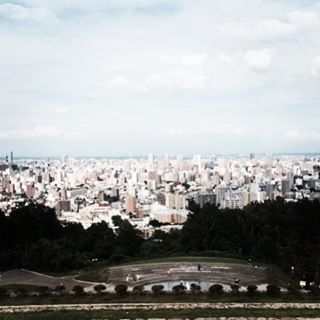
Sapporo is finally starting to feel like home. Some of that, I’m sure, is just the time passing and things starting to feel less and less strange. Some of it, of course, is that my Japanese is steadily improving (I still have a long way to go, though). In the beginning of the month, my buddy, Shoma, took me to a place where I got a really good view of the city!
This month, I finally got outside of Sapporo, if only for a weekend, and it was the most fun I’ve had since coming here. I went to the Rising Sun Festival, a two day long music festival held once a year in Otaru, which is just north of Sapporo. We rented a camp site for the weekend, so we were there from Friday morning until Sunday morning. It was awesome! All the bands were Japanese, so while there were a few I wanted to see, I had never heard of the vast majority of them. Fortunately, my Japanese friends knew which bands to watch.
Getting to the festival was surprisingly easy. We (my house-mate, Michael and I) took the subway to the northern most stop (about a half hour away) and then boarded a special shuttle bus that took us the rest of the way. Navigation was simple; as was to be expected, there were tons of employees carrying signs that guided us to the bus—plus the festival is huge so all we really had to do was look for the line of young people…lol. Once we arrived we met up with our Japanese friends.
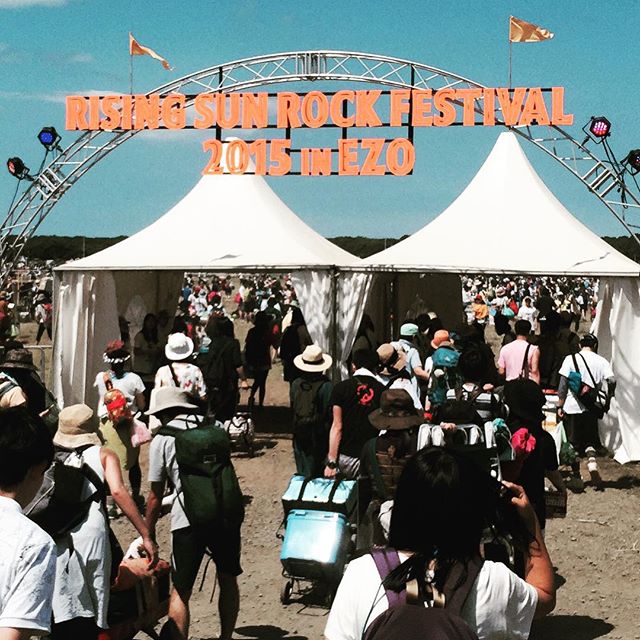
We saw about a million bands, but rather than bore you with a list of bands that I think are awesome, I want to talk about the experience of being at a rock festival in Japan. First, it was incredibly clean. I mean pristine. In America, you could expect the whole place to be covered in beer cans by the end of the second hour, but people simply do not behave that way here. Unlike Sapporo, there were trash cans everywhere (complete with garbage sorting crews to help separate garbage from recyclables). There was even a bathroom attendant to manage the lines at the porta-potties… though my friend, Norikatsu, insists that this is strange, even for Japan. Mostly I felt bad for the attendant since portable toilet smell is a universal truth.
People also obey rules for crowd control. Some of the stages were enclosed, so if a band was especially popular, the crowd would spill outside the venue. At this point, people that worked at the festival would rope off the area in order to make sure that traffic could still pass. Everyone obeyed these rules. Smoking was also like this. There were designated smoking areas set up around the festival, and I never saw a single person smoke outside of these areas. It was small touches like these that made the whole event seem way less unruly than a festival in America. Thumbs up, Japan!
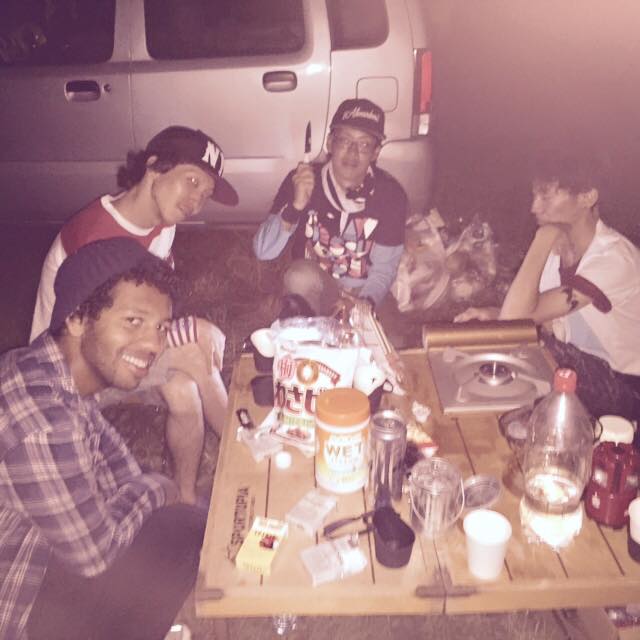
Now, let’s talk about food. Even at a rock festival, the food was incredibly good. Various vendors from around the Sapporo area had set up booths where they served basically anything you could want. My friend, Tsushima, works at a Soup Curry restaurant in Sapporo, and his spot also had a vendor at the festival. Even convenience stores had stores set up around the festival. The most surprising part of all this was that the prices were exactly the same as they would have been in Sapporo. I guess price-gouging festival-goers isn’t a thing here. Not to be all hipster, but I also had an amazing artisanal mocha.
As I said before, we camped out at the festival. I use the term, camp, very lightly however. We brought a portable stove, and table, beer, ect. We were definitely not roughing it. The first night we were there, we made curry rice and sat around listening to the late night djs, who we could hear from our tent. Towa Tei was djing!!! Maybe that doesn’t mean anything to you, but as someone who came of age in the 90’s, I consider him a legend . My Japanese friends, however, were still worried because there wasn’t any way to shower or, GASP, wash one’s hair. Michael and I found this pretty hilarious. I mean, REALLY you can’t go without washing your hair for 24 hours?!
So we’ve established that I was well-fed, caffeinated, and had dirty hair. Let’s talk about concert culture in Japan. Everyone buys merch. A ton of merch. Most people wear their band t-shirt to the band’s show, and also wear wrist bands supporting said band. On top of this, towels are also a big seller. They’re not quite as small as hand towels, but nowhere near is big bath towels. People wrap them around their necks. I, too, took part in this phenomenon. When it got cold, the towel also functioned as a scarf. I still can’t get up the nerve to wear a band t-shirt to that band’s show, though. Doing that is considered so uncool in the US, and I just can’t break out of that mindset. However, I think it’s really cool that people do that here. It makes the environment seem so supportive of the band.
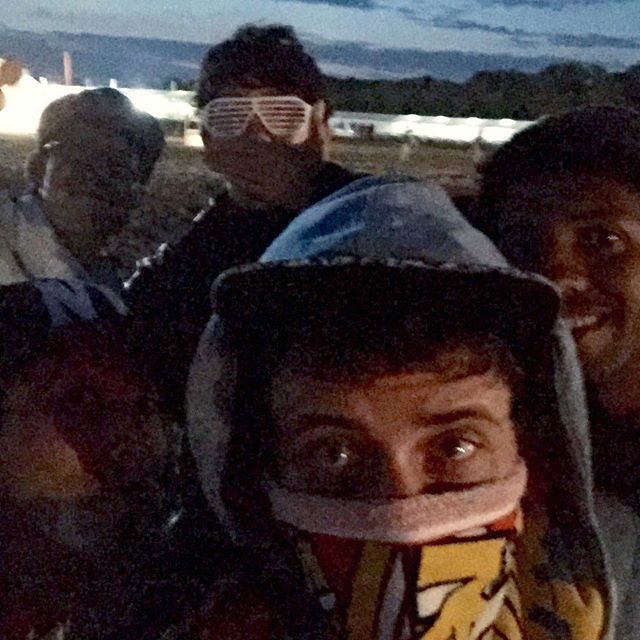
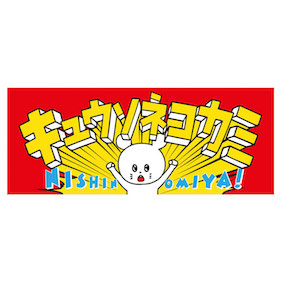
It was an exhausting two days. The first day’s show went from 2pm to 2am and the second day’s went from noon until 430am. This, I assume, is why it’s called the Rising Sun Festival: we watched the sun rise (which, for the record, is really early here. The sun is out in full force by 5am). It was great to see so many bands, but really the best part was spending two solid days with my friends. Even if I’m drinking and having fun, as long as it’s all Japanese, it’s still practice, right?
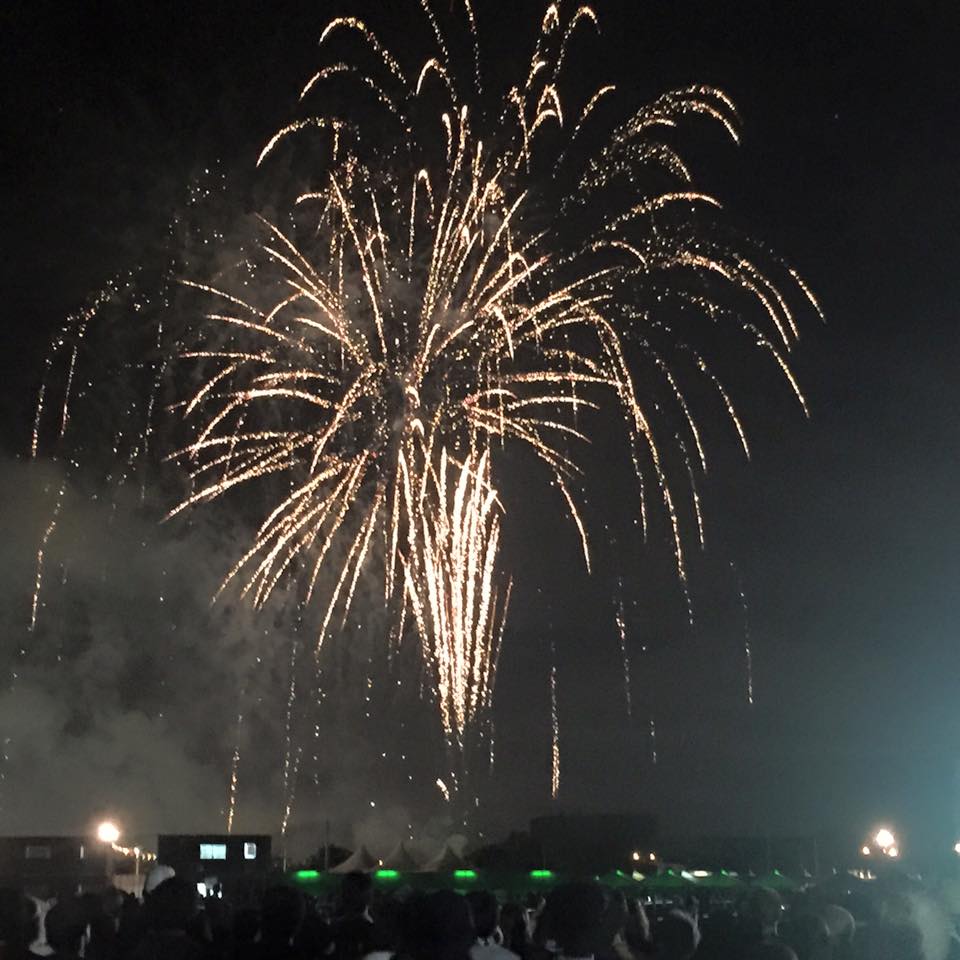
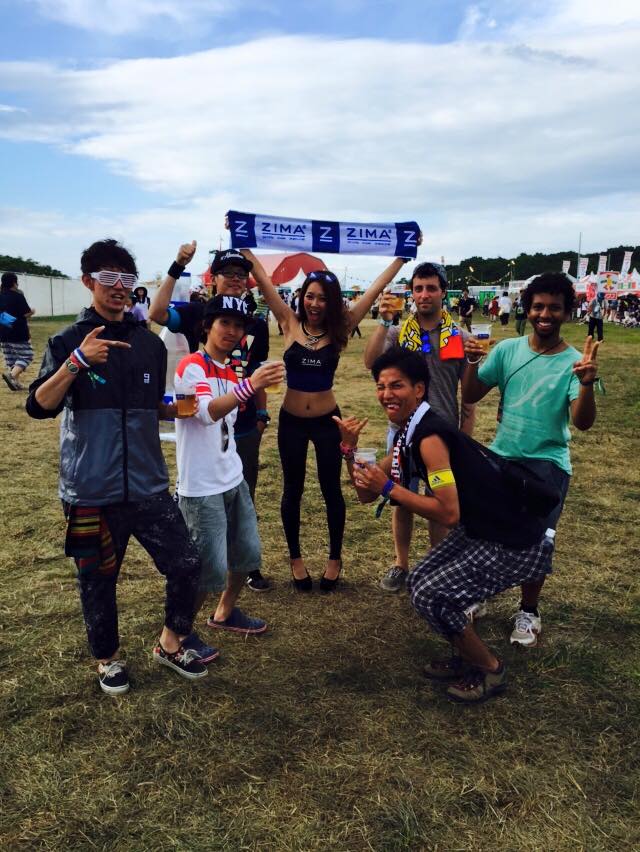
Finally, there was a Zima tent. I had thought that such beverages had long since been eliminated from the earth do to their gross-ness, but I was wrong. Being the idiots we are, we decided to get some, and the people at the Zima tent made us take a picture with the Zima girl. It was funny. See you next month!!
July 2015
Hi everyone, how is your summer going? It’s getting really really hot here (though not as hot as New York). There’s no AC in DK house so I’m sweating all the time!
Armed with a much more positive outlook, I managed to have a lot of fun this month, despite being very poor. Still haven’t really gotten out of the city yet, but I’m sure I will, in time. Lots of important personal things happened this month – it was my birthday, and one of my closest friends got married in New York – so I think it really had the capacity to be a lonely and sad kind of month, but instead I had a great time. Like I said in last month’s post, it really comes down to your perspective.
First, school really picked up this month. My class is full of fairly serious students, and our teachers really listened when we told them that class was too simple. So it got really tough. And I love it! We are responsible for new vocabulary (between 20 and 30 words) every day, with daily quizzes. In addition, we are now reading more complex passages and studying lots of new grammar. Between this sudden change at school and my work schedule, I’ve gotten pretty busy.
First I want to begin with something that actually happened at the end of June, but didn’t really fit into my post last time. On the Hokkaido University campus, there was a cultural festival. Basically, it was blocks and blocks of stalls created by the students with a ton of different things to eat. The picture on the right is from the festival. To give you an idea of the scope, it took about 45 minutes to walk from one end of the festival to the other, and there were also multiple side paths with even more kinds of food.
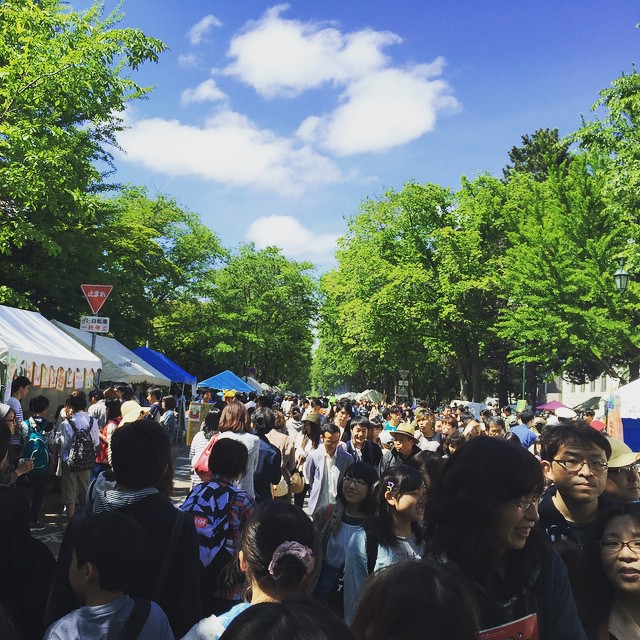
At the far end of the festival, there was also a stage where various school clubs performed. I saw some acapella and also a rock band.
I was actually worried that July was going to be a really depressing month. One of my best friends was getting married back in NY, and I was pretty bummed that I wouldn’t be there for the wedding. It was the first event with my friends that I was missing because of my move. Plus, my birthday in on July 18th, and if there’s ever a time that you want your friends around, it’s on your birthday. Despite these worries, it ended up being a really cool month because of my birthday.
Sorry guys, I still haven’t been able to get out of Sapporo, but I’m hoping that next month, finally, I will have the means to do so. In the meantime, here’s another picture of a park I stumbled across while I was walking to work.
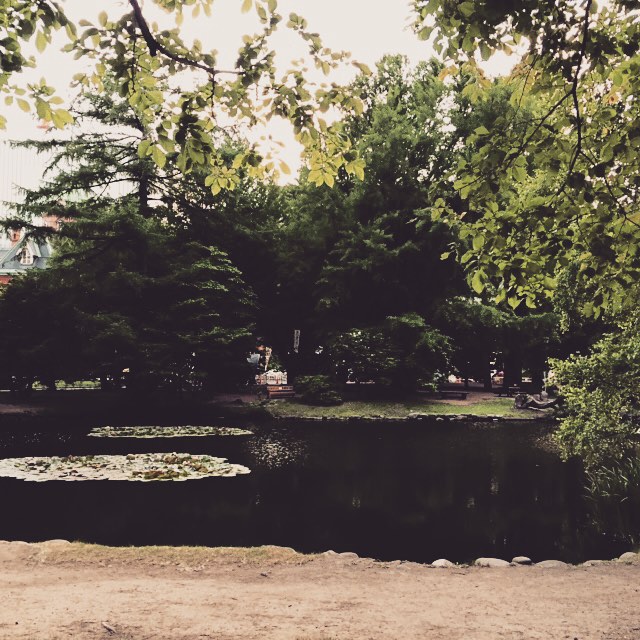
As I was saying, my birthday was looking like it would almost definitely be depressing: I had to work the whole weekend, and to make things worse, there was a festival that I had really wanted to go but couldn’t afford the price of a ticket.
But, everyone really made it a great birthday. The DK house people made a cake for all the July birthdays, my work made me a cake and gave me a bottle of whiskey, and two of my Japanese friends took me and my roommate, Michael (who’s birthday is two days after mine), out for dinner. They also gifted us with plastic samurai swords and traditional Japanese summer clothes. All in all, I didn’t feel lonely at all; maybe I’m finally adjusting?
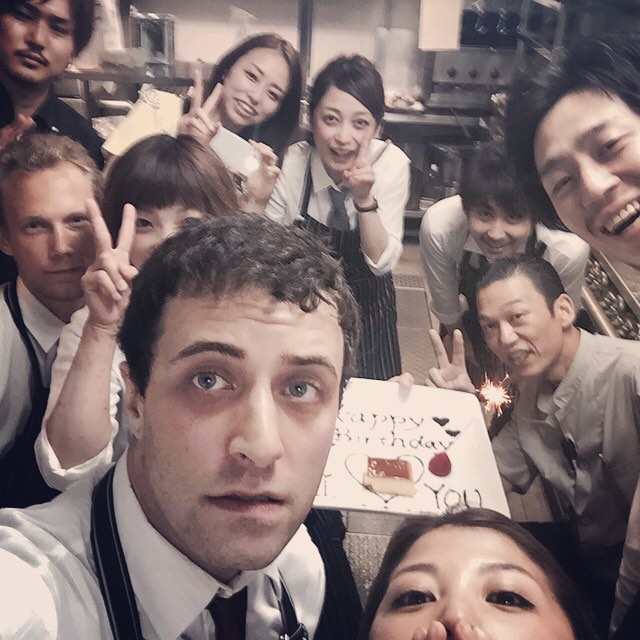
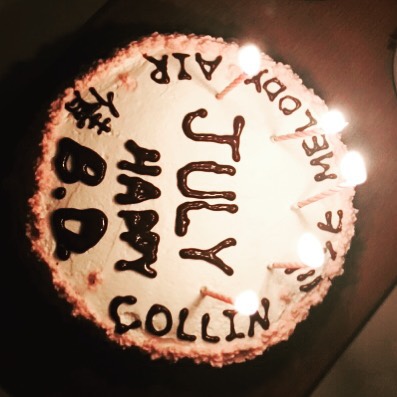
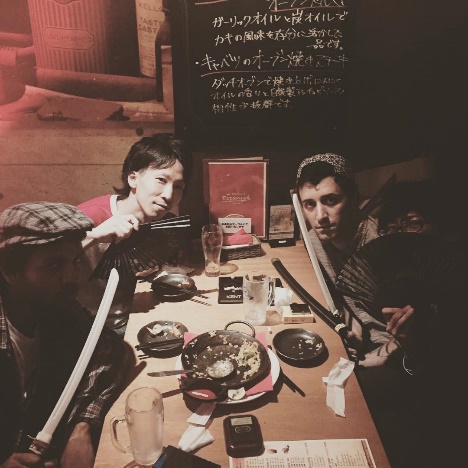
Next month, I’ll definitely have more to report, since I purchased tickets to the biggest music festival in Hokkaido, Rising Sun Fest. I still can’t really afford it, but I decided to give myself a birthday present. The festival is about 2 hours outside the city, and I’m excited to finally get out.
I’ve always been a very serious student (just ask Yasushi). But I’m realizing more and more, that while it’s good to be serious about school, it’s important to take the time to enjoy my new surroundings. I spent most of the month studying and working but I ate some good food, hung out with some great people. Little by little, I like it here more and more.
June 2015
Hi everyone!
This month was a tough one for me. After two months filled with everything exciting and new, some of the more negative things about my new life started to sink in. Really, everything about this has to do with me and nothing to do with Japan; It’s really just a part of being so far away from home, I guess. Anyway, I thought about not posting anything for the month of June, since July will be a lot more fun (As I’m writing this, It’s mid July now), but I decided that these tough times are also a part of living abroad and that maybe talking about it would help other people, so I’ll do my best to explain. Even now, I’m not sure it was really homesickness, but I guess that’s the best word for it. That and culture shock maybe.
These feeling first began in May, and came in went in bits and pieces. The first time I felt truly at odds with my setting was at the Urbangarde concert. I had been so excited to see them since before I moved—they had never toured in the US and I had known about their show in Sapporo since before I had even purchased my ticket to move. But on the day of the show, I felt scared rather than excited; what if someone at the venue said something to me that I didn’t understand, what if I didn’t understand appropriate concert manners in Japan and accidentally did something rude…? But, I told myself it would be fine and went anyway, of course. And of course it was worth it! They were great! But again during that show was the first time I could truly feel that I was not a part of my new city. Urbangarde relies heavily on satirizing culture. I had always know this, and it is part of what I find so interesting about them, but being at their show, I couldn’t help but feel that I didn’t belong—I had no business satirizing a culture that is not mine, after all. Nobody treated me strangely, (though I think I was the only audience member that wasn’t waving a parody of the Japanese flag during the show, but at that moment I felt incredibly far from home. What business did I have even trying to understand this strange new world? I felt locked out and alone. Of course through the concert I was able to relax and enjoy myself, but my initial sense of isolation was a precursor of my month to come.
I chose to move to Sapporo rather than a larger city in Japan because the city, and the school I attend, has very few native English speakers. I was worried that if I was around other English speakers I would take the easy way and spend more time speaking English than Japanese. Until I moved to Sapporo, everyone I knew who spoke Japanese spoke English fairly well, so communication was never an issue. Even in Japan, I’ve met plenty of people who speak English and Japanese but I have definitely been spending more time communicating in Japanese than English. This was good for my learning but the stress of having to make friends in a foreign language was taxing. And even with people who could speak English, I couldn’t speak with ease and comfort; everyone was a new acquaintance and so I was always navigating both language and also new relationships. While I didn’t miss New York, per se, I missed having places and people with which I could fully relax, say whatever I wanted, and feel at home.
This feeling in my daily life was compounded by the job I started at the beginning of June. I am working at a Brazilian restaurant where the owners hope to promote an “international” feel by hiring many foreigners to perform the job of “pasador”. My job is take large skewers of meat from table to table and serve them to the guests. While my coworkers are a very pleasant group (a quarter foreign and the rest are Japanese), it does mean that my job is to play a role as some kind of exotic foreigner. This atmosphere, coupled with the stress of a new job, only made me feel more depressed and alone.
Maybe to biggest reason I was feeling down was because of school. School, at that time, was very easy for me. Since my whole reason in coming here was to improve my Japanese, I was left wondering why I had come here at all. To make things worse, while I was excelling at school, I found myself at a loss many times during normal conversation. This discrepancy made me feel frustrated, as though the whole thing was useless.
I’m not writing all of this merely to complain, however. I wanted to explain all this because it’s bound to happen to anyone. And in my case at least, time, plus a slightly different outlook, allowed me to feel much better about my circumstances to the point where I feel much more excited about my life in Japan.
SOLUTION 1: TIME
Of course, you can’t feel blue forever. Even though I knew things would be different here, and even though I had been wanting to move here for years, it’s unsurprising that I would feel a little lonely. But as one acclimates to new surroundings, things that seemed daunting, like talking to new people in a foreign language (this ranges from new friends to the grocery check-out line) feel less and less scary every time you do them. The key is to let yourself feel uncomfortable and know that feelings can’t hurt you. Plus, it’s okay to feel scared. Absolutely nothing great comes from feeling comfortable all of the time. The human brain is very powerful, and if you force yourself into new situations all the time, your brain will learn that it has to adapt. Soon enough, I was able to have more normal conversations with greater ease and not feel bad if I didn’t get something right away.
SOLUTION 2: OUTLOOK
This is the big one, and the major point that I wanted to make in writing all of this. If you think people are being rude and cold or whatever, maybe it’s you. It’s easy to look at everything from your own cultural perspective, but much harder to continue to assume the best about people in the face of signs that indicate otherwise. I got sick to death of people talking to me like I couldn’t understand what they were saying. These interactions left me thinking that the Japanese must think that foreigners are stupid. I’m not saying my ability in Japanese is great, but it is definitely above the level at which people insisted on speaking to me in. However, it was my perspective that was wrong. The people that spoke this way to me were simply trying to make me feel comfortable and make sure I understood. There is absolutely nothing wrong with trying to make sure you are understood. If anything, it was them going out of their way to try and make me feel safe and comfortable. Perhaps they were going too far in my case, but what I realized was that there is no reason to look at an act of kindness from the perspective that it carries ill intent.
On the other hand, that’s not to say that I haven’t had some problematic interactions. As I said before, my job hires foreigners in order to foster a more “international” atmosphere. The implication here is that somehow all westerns share a common personality trait that the Japanese lack. I continue to think that this is crazy. Basically, my bosses seemed to want me to be louder and more brash all the time. I’m not that person. Sure, I wear strange clothes and my arms are covered in tattoos, but actually I’m not one to use a loud voice and I’m pretty shy. I felt like they were telling me that I shouldn’t be myself. And maybe they were, but after a couple weeks on the job, I could see my coworkers changing their perspective. The customers, too, responded to me well, and soon enough the criticism stopped. Initially, I felt angered by the things my work place was asking of me, and I could have gotten angry, or quit my job, but by sticking it out and doing the best I could, I’ve quickly become a valued member of that work place, and maybe even changed their perspectives of the outside world. Or maybe I’ve just changed their perspective on me. Either way, even when dealing with these kinds of interactions, the key is most of the time, railing against the status quo isn’t really the solution. You can’t make people think differently, you can only do your best to be kind and patient and hope that the rest falls into place. Despite cultural differences, people are people and we are all trying to do our best. It’s important to not forget that.
Being far away from home can be tough. But I’ve realized that it’s important not to get stuck inside my head about it. If I just keep doing what I’m doing, things will steadily improve. Nothing worthwhile comes easy anyway, right?
Sorry that I don’t have more exciting news for June. Like I said before, I thought about not writing this blog at all but then I decided that maybe it would help someone else who experiences these feelings in the future… Anyway, I promise to do more fun stuff next month, so I hope you’ll stick with me
May 2015
Hello from Sapporo! I’m sorry that it’s been a little while since I’ve written anything! I went through a major adjustment period in the last few months, so please bear with me and I promise to update more regularly from here on out!
My second month in Sapporo began with a trip to Nakajima Park, which is one of the larger parks in the area. It was beautiful and I felt the scenery here was especially Japanese. What do you think?
It was a one of the first warm spring days of the summer, around 70 degrees with a nice breeze. We even rowed a boat around the lake which for which the park is named (Nakajima literally means center island).
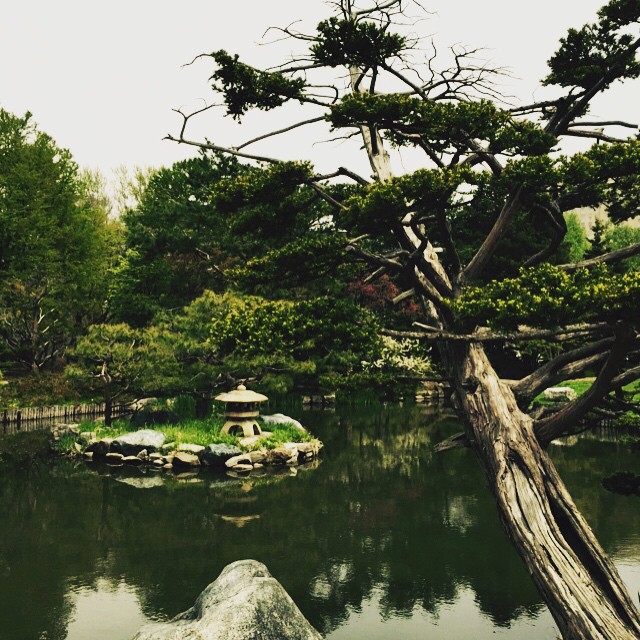
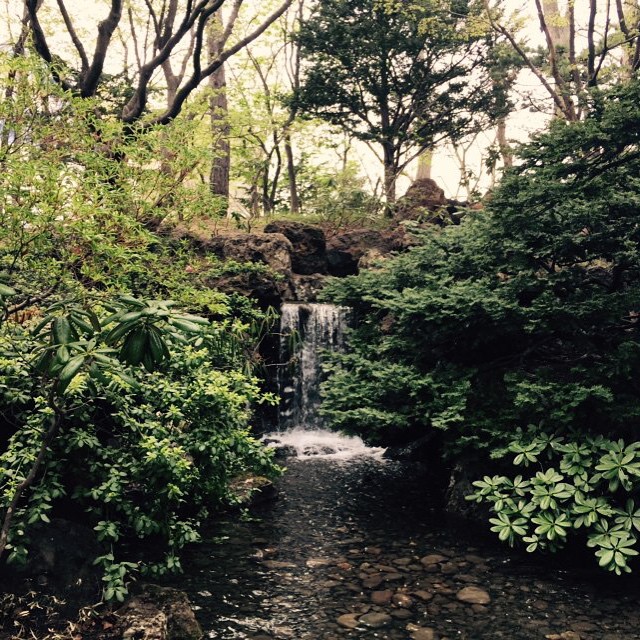
As a poor student, I didn’t get out of Sapporo, really, but having only been here a month, there was still plenty for me to do, even if I didn’t leave the dorm. I know I said it in the last post, but deciding to live in a share house was a great decision. I make food with my friends about once a week and every month a large group of us get together in our living area and make some really good food. It’s great for me because, even though I like to eat everything, I still don’t really understand Japanese cooking. Even if I look up recipes on line, it’s hard for me to know what the ingredients are when I’m out shopping. Actually, lately I’ve been trying to read recipes in Japanese because of this. I didn’t realize it while I was living in America but, many ingredients are changed in English versions because the traditional ingredients aren’t sold in the states.
Anyway, because of my friends at DK House, one of whom is a chef at a Soup Curry restaurant (for more on Soup Curry, see last month’s post), I get to eat all kinds of awesome food. In May, we made Okonomiyaki and Takoyaki. In New York, at least, there are manty restaurants where you can order Okonomiyaki, so if you haven’t tried it yet, you definitely should! However, I guarantee that whatever you order at a restaurant won’t be as good as the home-made version I had here!
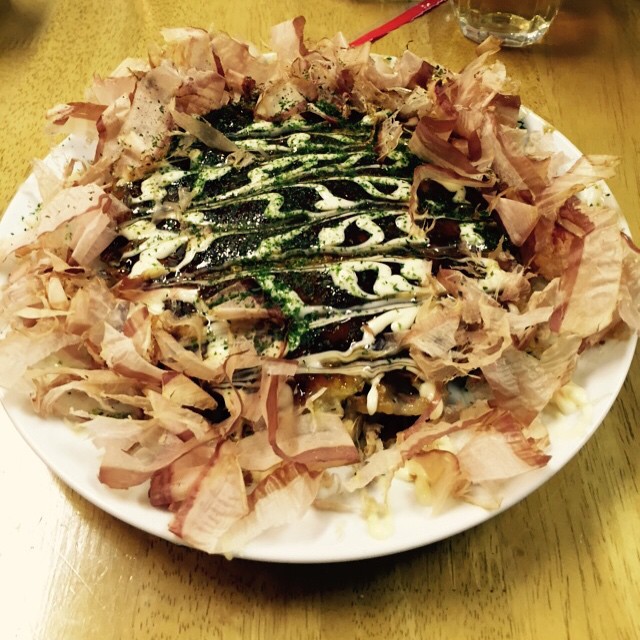
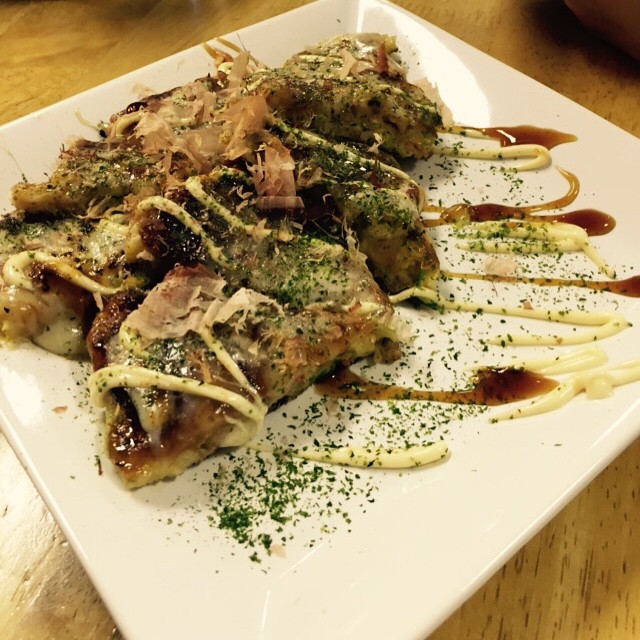
With summer fast approaching, the scenery all over Sapporo was becoming beautiful and green. My walk to school, which has a beautiful mountain backdrop, went from being somewhat grey and cold-looking to beautiful and green almost overnight. With the temperature on the rise, our teachers decided to take us on a short spring outing. We went to a ski area about an hour’s drive outside the city and played a game called “Park Golf”. I don’t know if this game exists in the states or not, but if it does, I’ve never heard of it. The easiest way to explain it would be to call it the oversized version of miniature golf, but without the man-made obstacles. The rules are the same as golf, but you use a big mallet and a large ball. Since we played it on a ski slope, each hole had hills and mounds as natural obstacles. Here’s the view from the slopes! I can’t wait to go there again in the winter for some snowboarding!
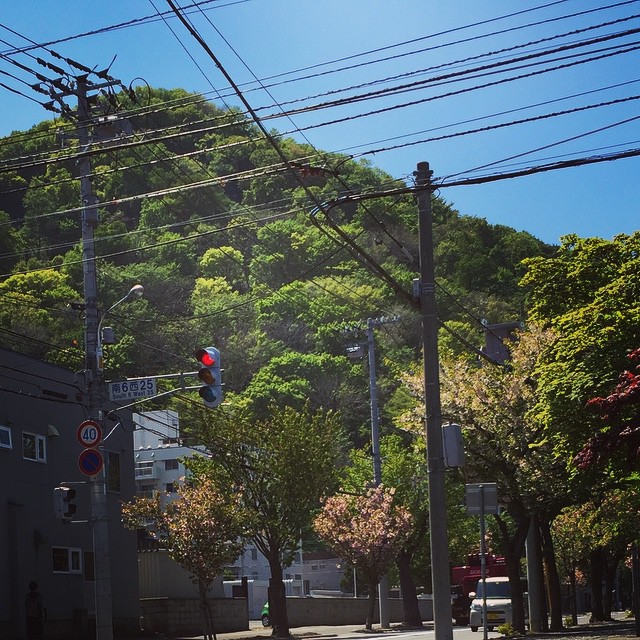
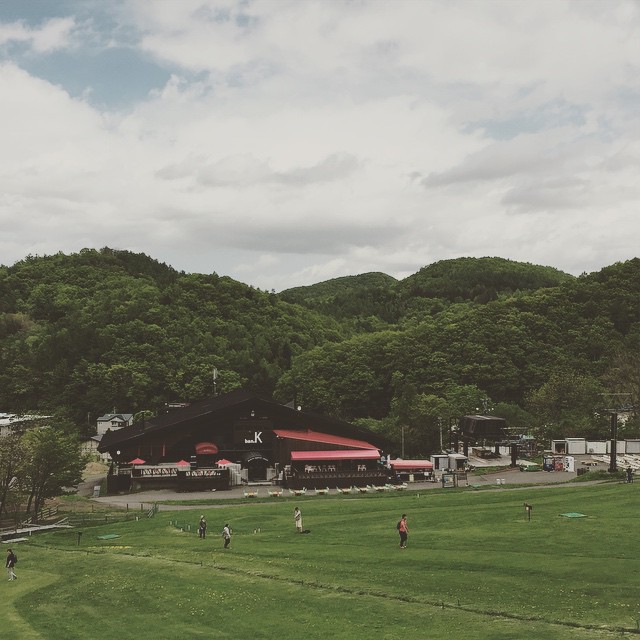
I had lots of fun this month, but my favorite thing was going to my first live shows in Japan. I’m a huge music fan and going to see shows in Japan is something I’m definitely planning to do as much as possible. This month I was able to see both a recent favorite, Urbangarde, and a band I’ve been listening to for years, Polysics. I also got to see a local Sapporo punk band, Saishuu Shoujo Hikasa (最終少女ひかさ Last Girl Hikasa), who opened for Urbangade. It was rad. WARNING: Many have described my musical tastes as “strange”, so if you seek these bands out, be aware that you might not like them
Rather than boring you with the musical details of bands you might not care about, I’d like to talk about my experience seeing live music in Japan. Tickets, even to indie shows in smaller venues, cost $40 or more. Purchasing of tickets can be done on a special machine at most convenience stores (like 7-11). In the case of the Urbangarde show, I also had the option to purchase a package deal that included the bands newest cd. Selling merchandise at shows is a much bigger deal here than in the states, but more on that in a minute. After I presented my ticket at the door, I had to pay an additional $5 for a drink ticket at both shows. I don’t like to drink at shows because I don’t want to lose my spot in the crowd in order to use the restroom, but even though I didn’t end up using the ticket, not paying for it was not an option. After entering the venue, there is usually a sales person from one of the major record stores selling CD’s (actually, I don’t know if this is the case every time, but it was like this at both the shows I went to in May). As I said before, a variety of band merchandise can also be purchased, but this seems to be done in a slightly different location. It seemed like everyone at the shows bought band merchandise. Almost everyone was waving the flags that Urbagarde sold at the show; at the Polysics show, everyone was swinging special “POLYSICS OR DIE!” towels above their heads. Many people bought t shirts that they immediately put on. In the states, wearing a band’s t shirt to that band’s show is considered uncool but here it seems to me that this behavior is seen as showing support to the band and therefore encouraged. To me, this behavior seemed to promote a sense of unity amongst the audience. The audience is actually the coolest thing about seeing a show here. In America, people talk. They talk in between songs, they talk during the show, they talk whenever they want. Nobody talks during shows here. From the moment the beginning of a song starts until the last note ends, the room is dead silent. People cheer after songs, but if the band suddenly starts playing the next tune, everyone abruptly stops. It was so nice to enjoy music without having to concentrate in order to tune out the side conversations. This sense of support between the band and the crowd is also obvious from the behavior of the bands. Towards the end of every set, the house lights are brought up and the band talks to the audience for 10-15 minutes. The touring bands I saw talked about what they had done, seen and eaten in Sapporo, talked about how grateful the were to be there, and asked for the crowds continued support. When the band said thank you, the audience cheered. When the band asked for the crowd to be sure and purchase their music/goods, the audience cheered and held up whatever they had bought. I’d never seen anything like it. If you can check out some live music in Japan, I definitely recommend it.
Usually, taking photography is forbidden at shows in Japan, but Urbangarde has a song about social media during which they encouraged the audience to take pictures. When they told everyone to take a picture, I thought they were joking, so I almost didn’t get my phone out in time!
I hope you enjoyed reading about my second month in Sapporo! Be sure to let Yasushi Sensei know if you have any questions or if you have any topics you would like me to cover! See you soon!!
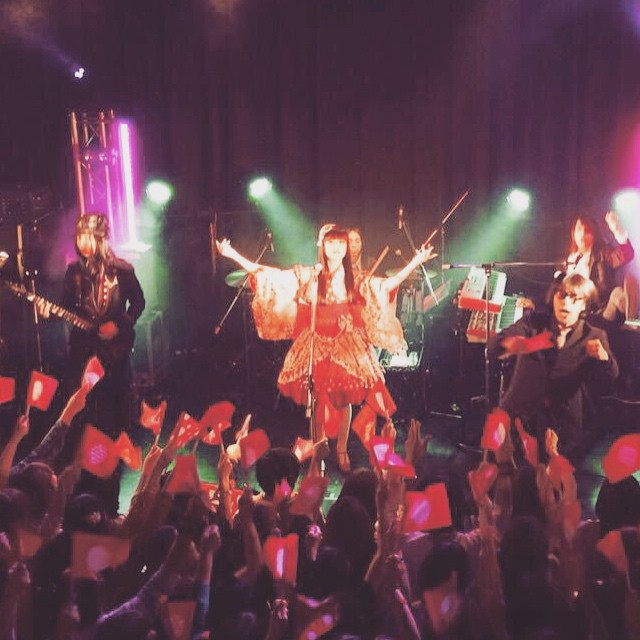
APRIL 2015
I can’t believe that my first month in Japan is already over. I’m still settling in and getting used to all the small differences between here and the states, but I really like Sapporo so far, and I’ve been able to have a lot of fun!
I’m not sure where to start, but I guess I’ll begin with my first night here. The flight was long but uneventful, and even getting everything from the airport to the hotel that I stayed in the first night was really easy. Even though I had been traveling for 16 hours, I was wide awake on the hour long bus ride from New Chitose Airport to the Prince Hotel in Sapporo. Looking out the window into the fairly quiet Sapporo evening, it was hard to believe that I was halfway across the world. Once I had gotten all of my luggage into my 25th floor hotel room, I was treated to a view of downtown Sapporo. I can’t believe I live here now! Then my stomach reminded me that I hadn’t eaten much in the last 24 hours so I took a short walk down the street to a Ramen shop that the lady at the front desk had recommended. Ramen is one of my favorite Japanese foods and something that Sapporo is famous for, so I was excited for it to be my first meal. (Full disclosure--when people ask me what I like most about Japanese culture, I usually tell them food and music…I love eating). Unfortunately, my phone was completely dead by the time I sat down to eat, so this first ramen of Japan will live on only in my memory. It was good, I promise
Waking up the next morning, I looked out the window to see Sapporo in the daylight for the first time. Of course, in the months leading up to my move I had been reading everything I could about Sapporo, but still I can’t quite describe how I felt that morning with the city spread out around me, surrounded by beautiful mountains that I hadn’t been able to see the night before.
My first morning in Sapporo
DK House (the share house that I live in) was only about a 10 minute walk away from the hotel, so I strapped all my luggage together and decided to walk over since it was such a beautiful day. Of course, I didn’t know the city at all and despite Sapporo being laid out in a grid that makes Midtown Manhattan look convoluted, I immediately got lost. Fortunately, hailing a cab was not a problem and I was at the door of DK house in moments.
I guess I should explain about DK House. It’s called a “share house”, which is a really fancy name for a dorm. Of the people that live here, about half are students, like me (though about a decade younger), and the other half are Japanese people who chose to live here for various reasons—more on that later. My room came equipped with a heater, fridge, desk and a closet. Downstairs is a large shared living area with a fully equipped kitchen and lots of space to sit around. I was really worried that I wouldn’t like living in such an arrangement, but now that my first month is over, I can definitely say that DK House has been great so far.
But before I talk about that, I want to talk a little bit about school. Right now, I’m taking what they consider the final bits of their upper level beginner class. This course is designed to prepare students for the N3 JLPT. In June, I’ll begin intermediate classes which are designed for students who want to take the N2. The class I’m in right now is a bit basic for me, but as I’m still adjusting to life abroad, I don’t mind that the class is a lot of review. Class lasts from about 1 pm until 4:30, Monday through Friday. The structure of the classes is great. It focuses heavily on listening and speaking, which is great since the focus back home was on grammar construction.
Anyway, now that I’ve explained the basics, a little more about what I’ve been doing with myself. The school requires that new students not work for the first month that they are here. Since classes are only three and a half hours of my day, I have a lot of free time. Mostly, I spent that time walking around trying to explore the city. This was hard at first because I couldn’t use my phone for maps or GPS. I decided that the first thing I had to do was get a phone.
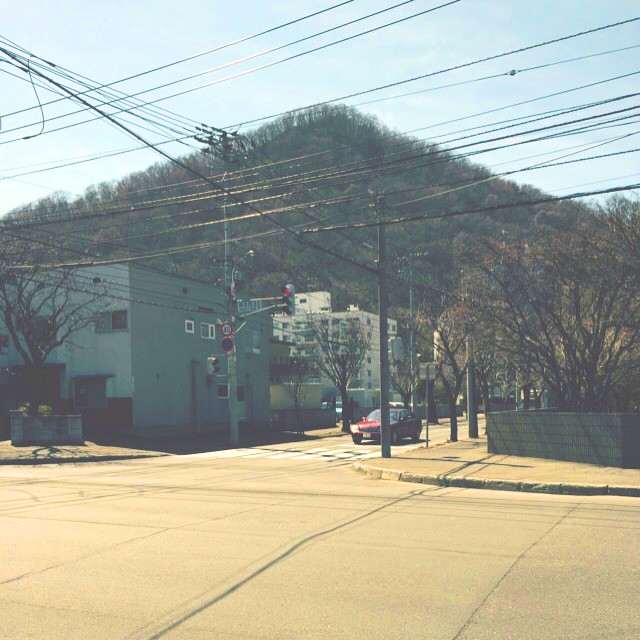
The view on walk to school
I went to Soft Bank, which is a major Japanese carrier, in order to get a new iPhone. When I sat down at with the lady who worked at the store and told her I wanted to get a new iPhone and sign a new contract, the first thing she told me was that they did have any iPhones in stock. However, I didn’t know the word for “stock”, so I had to pull out my dictionary. I felt really embarrassed, but then she did something that really surprised me; she took out a piece of paper and wrote the word down (with furigana!) and then proceeded to write other useful words (new contract, ect.) as well as other useful phrases (I have my passport and my foreign registration card). Since there was no way she would be getting a sale from me that day, I really couldn’t believe how much time she was taking to do all of this for me. It was really kind, and I can’t imagine such a thing happening in New York. The next day, having memorized the vocabulary she gave me, I set out to get a cell phone again. Unfortunately, there weren’t any other nearby Soft Bank stores, so I ended up going to Docomo. The man that helped me there was equally as kind, and while he was setting up my account he told me he had studied abroad in France as a high school student. Still, I felt a little guilty for not sticking with Soft Bank after the clerk there had been so helpful…sorry Soft Bank!!
Armed with my new phone, I felt much better about wandering the city, but by that time I had already made a couple of friends at the dorm. The dorm has been a great place to meet people. My core friend group consists of Rena, a nurse who loves to travel; Shun, a salary man who speaks 5 languages; and Michael, a German student who studies at a nearby university. Rena and Shun both speak English well, but don’t seem to mind when I force them to speak Japanese. Michael is just starting to learn Japanese, but already speaks English. Our conversations tend to shift between Japanese and English. I try to force Japanese as much as possible, and the exposure has really improved my listening and speaking. The four of us started a tradition of making a big shared meal every Thursday night. In April we did this three times, and we made Nabe each time. Nabe is a big soupy hot pot with meat and vegetables. It’s easy to make, really filling and much more nutritious than my steady diet of instant ramen.
Even though I had only been in Sapporo a couple of weeks, I had friends come visit. It just so happened that my New York City bandmate, Melissa, and her husband, Dave, were traveling in east Asia, so they decided to come for a weekend. Of course, I still didn’t know the city at all so Shun and Rena, as well as another Japanese friend, Kazuko, helped me take them out. Of course we had Ramen again, but the highlight for me was my first trip to a real Japanese Izakaya. Izakayas are like a bar / restaurant that has a little bit of everything on the menu. Also, all-you-can-drink specials are a thing here. You pay about $10-12 per person and can drink as much as you want for two hours. I can’t imagine people allowing this in the states, where I’m sure everyone would drink until they puke, but maybe that happens here, too? Anyway, we had a lot of food that I’d had before, and some things I hadn’t (grilled Hokke, some kind of really salt octopus, seafood nabe, to name a few). After this, Kazuko took us to a Jazz bar located in a basement a short walk away from DK House. Two older men were playing jazz standards on a guitar and piano. The place was lit in blue lights and I couldn’t help but think I had entered a Murakami novel. It felt like I was having a strange jazz dream and I was pretty sure the sheep man was going to show up any minute, or maybe I was going to meet a girl with perfect ears… (Please read Murakami’s novels…they are really strange and awesome!)

At the Izakaya: from top right, clockwise: Michael, Dave, Melissa, Kazuko, Rena, Shun.
The final event of my first month in Sapporo was a school trip. As I haven’t really had a lot to do my first month here, I joined the school’s event planning committee and our first task was planning the school trip to the park to see the cherry blossoms when they bloomed. So just in case you aren’t familiar with any of this, there are a couple of important points that I feel I should mention. First, the Japanese love cherry blossoms, and for good reason. They are absolutely beautiful. Second, they only stay in bloom for a very short period of time before the wind carries all the petals away, and this brevity only adds to their beauty. Therefore, planning the trip was very important. Around this time, the news was filled with reports on where the cherry blossoms were currently in bloom and there was a calendar showing predictions of when they would bloom across Japan (generally, the movement of the blooming begins in the south of Japan and slowing makes its way north). Sapporo cherry blossoms usually bloom in the beginning of May, but due to some unseasonably warm weather, it was thought that they might bloom earlier than expected. Because of this, the committee took a gamble and planned our trip on the early side. The danger was that there might not be any cherry blossoms, but with a national holiday on the following week, the other option was a week later, and we worried that they would already be done by then. Fortunately, we were right to plan when we did. I trip happened on Showa’s birthday, which is a national holiday that marks the beginning of golden week, which is a week-long vacation for most of Japan. I was on the “Find a Location” team, so my job was to meet with a few other students and claim space for the 100 or so students that would be joining the event. Even though we arrived at the park at 6 a.m., all of the prime space had already been claimed!! Another thing that amazed me was that most of this space had been claimed by people marking it with large blue tarps, but there weren’t any people to guard it! Although I saw a few people with sleeping bags, which made me realize some people had actually slept in the park the night before in order to grab a spot underneath the cherry blossoms!
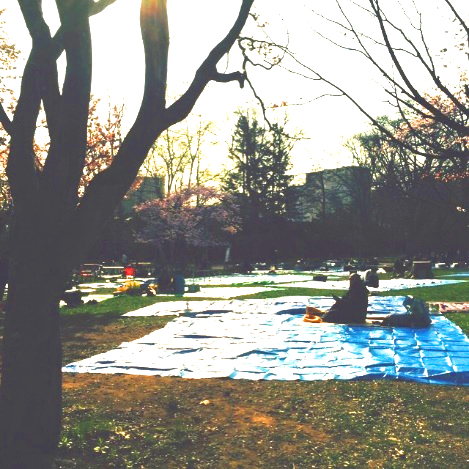
A sea of tarps in the morning…we were so far away from the cherry blossoms
My team arrived at the park at 6 a.m. and then a couple of our teachers joined us around 7:30. They brought us coffee and breakfast and waiting until 11 when the students were to arrive. When the students arrived we picked up 3 large gas powered grill and made a combination of lamb and vegetables, inexplicably called Genghis Khan, that I’m told is another specialty of Sapporo. My teachers kept insisting that beer and Genghis Khan were a perfect combination, and I am happy to report that they are correct!
Later that day, I met us with Shun, Rena, Michael and his friend, Miriam, who was visiting from Germany. We walked back to the park and did some of our own cherry blossom viewing. It was a great way to end my first month in Japan.
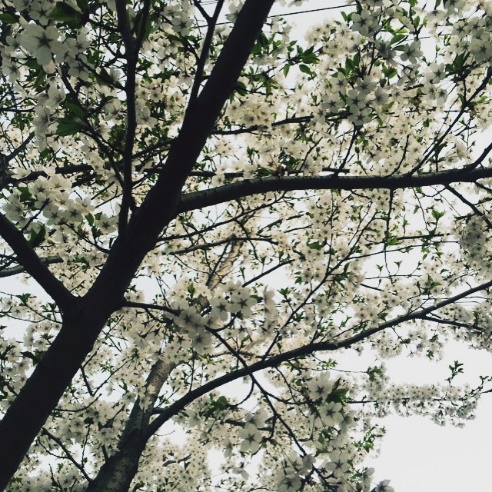
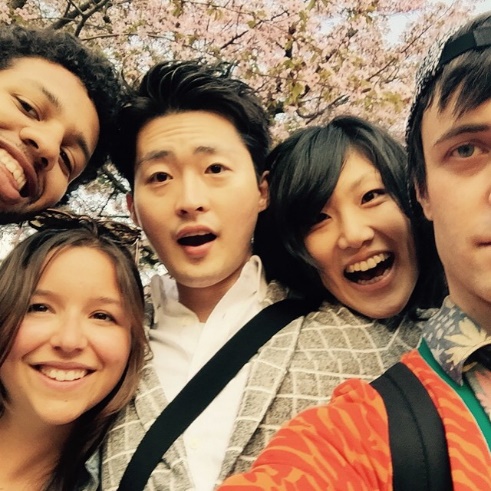
Today's Yasushi
泰史的每日小课堂/야수시의 하루
June 2014 |May 2014 | April 2014
ねこが、うらやましい
Wednesday, June 11 2014
日本語(日语)
一日中寝ていられるネコがぼくは羨ましいです。
■単語 VOCABULARY
一日中(いちにちじゅう):all day long
寝て(ねて):to sleep
ネコ(猫/ねこ):cat
羨ましい(うらやましい):envious
昨日(きのう):yesterday
英語 English
I envy a cat that can sleep all day long.
中文)
我很羡慕能睡一天的猫。
 |
中国のお茶
Monday, June 9 2014
日本語(日语)
昨日、中国人の生徒からもらった龍井茶を初めて飲みました。
それは日本の高級なお茶に似ていて、とても美味しかったです。
■単語 VOCABULARY
昨日(きのう):yesterday
中国人(ちゅうごくじん):Chinese people
生徒(せいと):student
龍井茶:Longjing tea
初めて(はじめて):for the first time
飲みました(のみました):drank
日本(にほん):Japan
高級(こうきゅう):highest
お茶(おちゃ):tea
似て(にて):similar
美味しかった(おいしかった):tasty
英語 English
I am planing to make a rice cake with kinako for lunch today.
What is the rice cake dish in China?
中文)
昨天我第一次喝了从中国学生那里收到的龙井茶。
味道和日本的高级茶相似,十分好喝。
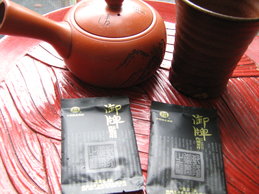 |
おもち
Friday, May 23 2014
日本語(日语)
http://bit.ly/1k1KABs
■vocabulary
今日の:きょうの
お昼:おひる
作ろう:つくろう
思います:おもいます
中国:ちゅうごく
お餅:おもち
料理:りょうり
英語
I am planing to make a rice cake with kinako for lunch today.
What is the rice cake dish in China?
中文)
今天的午饭我想做安倍川年糕。中国有怎样的年糕菜肴呢?
ゴジラ
Thursday, May 22 2014
日本語(日语)
3D
ゴジラは1954年に日本で
http://t.cn/8kJWgZ6
■vocabulary
映画:えいが:movie
上映:じょうえい:screeing
始まりました:はじまりました:started
生まれました:うまれました:was born
英語
3D screening of the movie "Godzilla" has started.Godzilla was born in Japan in 1954.
中文
ルシア先生)
3D电影“哥斯拉”已经开始上映。哥斯拉在1954年诞生于日本。
以下は参考までに
Googe)
电影“哥斯拉”的3D放映已经开始。哥斯拉诞生于日本于1954年。
Excite)
立体电影「哥斯拉」的放映开始了。1954年在日本生了哥斯拉。
Weblio)
3D电影"gojira"no上映开始了。gojira在1954年在日本出生了。
猫の名前はみい
Wednesuday, May 14 2014
日本語(日语)
こんにちは、ぼくは猫の「みい」です。いま起きたところです。
英語
Hello, my name is Mii the cat. I have just waked up now.
中文
大家好,我是叫“Mii”的猫咪。现在是醒着的时候
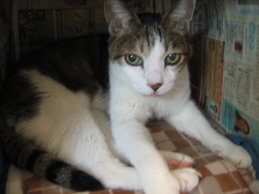 |
みりん
Wednesuday, May 7 2014
日本語(日语)
僕は、日本の調味料のみりん(味醂)をウォッカから醸造しました。
6ヶ月以上かかりました。
英語
I brewed my own sweet sake of seasoning of Japan from vodka.
I took six months or more.
I do not use the milk and eggs.
中文
我用伏特加酿造了日本的调味料味淋,酿制了六个月以上
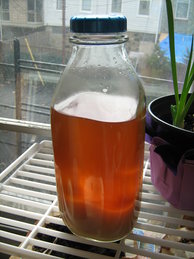 |
ベジタリアンのケーキ
Friday, May 2 2014
日本語:
昨夜は初めてケーキを焼きました。材料は小麦粉と砂糖と重曹と豆乳とココナツオイルです。
卵や牛乳は使っていません。
英語:
I baked a cake for the first time last night.
Material is coconut oil and baking soda and flour and sugar.
I do not use the milk and eggs.
中文)
昨天晚上我第一次烤了蛋糕。
材料使用了小麦粉、砂糖、小苏打、豆乳和椰子油。
没有使用鸡蛋和牛奶。
初めての自転車
Sunday, April 28 2014
日本語:
今日僕はニューヨークに来て初めて、公園以外で自転車に乗りました。
英語:
I rode on the bicycle today except the park only after I came to New York.
中文)
到纽约以来,今天我第一次在除了公园之外的地方骑自行车。
folding bike 折り畳み自転車
Wednesuday, April 23 2014
日本語:
近所の屋上農家に野菜や果物を買いに行くために、ぼくは折り畳み自転車を買いたいと思っています。
英語:
In order to go to the roof-top-farm and buy vegetables and fruits in my neighborhood, I would like to buy folding bike.
中文)
为去附近的屋顶农家买蔬菜以及水果我想买折叠式的自行车。
屋上農場
Wednesuday, April 23 2014
日本語:
うちの近所のビルの屋上には世界最大の屋上農場があります。
僕はそこで有機野菜を買います。
英語:
In my neighborhood, there is the lagest roof-top-farm in the world.
I buy organic vegetables there.
中文)
我家附近的大厦楼顶有世界最大的屋顶农场。
我在那里买有机蔬菜。
パンを焼きました
Saturday, April 19 2014
日本語:
今日ぼくは久しぶりにオーブンでパンを焼きました。酵母は、去年リンゴから自分で培養した天然酵母を使いました。
英語:
I remembered the supper eaten at the street stand in Beijing a long time ago, and made the "Chinese donburi dish" yesterday.
中文)
昨天我想起了以前在北京的小摊吃的晚饭,就做了中式盖浇饭。
中華丼(盖浇饭?)
Friday, April 18 2014
日本語:
昨日僕は、昔北京の屋台で食べた晩御飯を思い出して、「中華丼」を作りました。
英語:
I remembered the supper eaten at the street stand in Beijing a long time ago,and made the "Chinese donburi dish" yesterday.
中文)
昨天我想起了以前在北京的小摊吃的晚饭,就做了中式盖浇饭。
4月なのにニューヨークに雪
Wednesuday, April 16 2014
日本語:
昨夜ニューヨークは雪が降りました。もう4月なのにびっくりです。
英語:
It snowed last night in New York.It is surprising because it is in the middle of April!
中文)
昨夜纽约下雪了。都已经是四月了很惊奇
オーガニックの豆乳
Tuesday, April 15 2014
英語)
I drink organic coffee with soy.
日本語)
僕はコーヒーにオーガニックの豆乳を入れて飲みます。
中文)
我会喝放入了有机豆乳的咖啡
オーガニック・コーラ
Monday, April 14 2014
日本語)
家族の健康を考えてオーガニック製品を買っています。
たとえばこの写真は昨日買ったオーガニックのコーラです。
英語)
I buy organic products for my family health.
For example, this photo is of organic cola
that I bought yesterday.
中文)
为了家人的健康考虑,我
购买了有机产品。比
如说这张照片是我昨天买的有机可乐。
 |
Linax
Sunday, April 13 2014
日本語)
マイクロソフトがウインドウズXPのサポートを終了しました。
だからOSをリナックスに交換しました。
英語)
Microsoft ended support for Windows XP.
So I replaced with a Linux OS.
中文)
微软结束对Windows XP的支持。所以,我用Linux操作系统取代。
空手
Saturday, April 12 2014
日本語)
今日は2週間ぶりに空手の稽古に行きました。
英語)
Today I took Karate class two weeks since last time.
中文)
今天去练习了两周没有练的空手道
at the bookstore
Thursday, April 10 2014
日本語)
ぼくは今日、本屋さんで本を予約するつもりです。
英語)
Today, I'm going to book a book in the bookstore.
中文)
我今天想在书店约定一本书
まんが
Thursday, April 10 2014
日本語)
昨日、東京の義母から僕の娘に、「ダブルゲージ」という漫画が届きました。
中文)
昨天从东京来的岳母送给了我女儿《薬 双规》这部漫画
英語)
Yesterday comics called “Double Gage”was arrived for my daughter from my mother in law who lives in Tokyo.
GGダブルゲージ
Language School
We can make it at Cafe Zaiya on the 2nd floor of Kinokuniya bookstore or Open to Publice near the Grand Central station.
Cafe Zaiya@Kinokuniya bookstore
1073 Avenue of the Americas, New York, NY 10018
+1 212-869-1700
MAP
Open to Public
Pershing Square
Park Ave.
East 42nd St.
subway :4567s
MAP


